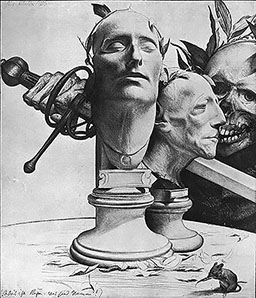The theme of transience, the permanent counterpart of life and death, runs through Richard Müller‘s entire oeuvre. The first examples of his fascination with this theme, which pitted the impotence of all things living against fate in the painter‘s mind throughout his life, appear shortly after the turn of the century. A striking example is the large-format drawing with six representations of Napoléon Bonaparte‘s death mask, which Müller created in Paris in 1906. The aura of this legendary commander (1769-1821) has clearly cast a spell over the draftsman here, for the artist goes far beyond a simple rendition of the objects before him. Indeed, he deftly heightens the atmosphere through a complicated interweaving of the variously-lit faces in a way that makes it appear as though the heads have begun communicating with each other. The three-dimensionality of the representation is enhanced through a subtle play of shadows, effectively breathing new life into the dead. The plaster seam, depicted as photo-realistically as it is, now becomes a scar, so to speak, of the deceased emperor. In 1913, Richard Müller used Napoléon‘s mask again, together with the distinctive profile of the Prussian King Friedrich II, for another gloomy portrayal of transience. He himself titled this sheet, upon which laurel-crowned death gleefully prepares to decapitate the dead sovereigns, What is Fame – What are Names? (Fig. 1).

